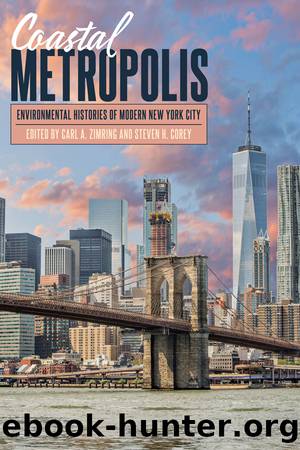Coastal Metropolis by Unknown

Author:Unknown
Language: eng
Format: epub
ISBN: 9780822987987
Publisher: University of Pittsburgh Press
CHAPTER 10
LEARNING HOW TO DREDGE IN THE AGE OF ECOLOGY
The Mud Dump Site and the New York Bight
David Stradling
The year 1976 was a rough one for New York waters. Three troubling stories unfolded over the first six months, heightening concern for the long-polluted New York Harbor and the New York Bight, the large open bay separating the New Jersey coast from Long Island. In February, Ogden R. Reid, New Yorkâs commissioner of environmental conservation, announced the closure of the Hudson River to commercial fishing due to accumulating polychlorinated biphenyls (PCBs) in the fish. Days later, state officials recommended limits to eating fish from the river, if not an outright ban. With these announcements, the growing danger posed by oily wastes dumped by General Electric into the Hudson over the course of thirty years became tangible. Once largely contained in the upper reaches of the river, tons of accumulated PCBs had been unleashed in 1973 by the removal of the Fort Edward Dam. Now the dangerous chemicalâa carcinogen that moves through the food webâwas threatening to wreak havoc on the entire Hudson-Raritan estuary ecosystem.1
Then, in June, unusual quantities of waste began washing up on Long Islandâs southern beaches. Tar and grease balls were joined by plastic tampon applicators, watermelon rinds, charred wood, pieces of Styrofoam, even chicken heads. Persistent south winds blew âfloatablesâ out of the bight and onto Fire Island, Jones Beach, and other popular summer destinations, some of which were closed when tests found high levels of coliform bacteria. Public health officials recommended that swimmers get precautionary inoculations against hepatitis. On June 23, Governor Hugh Carey declared Long Island a disaster area, requesting federal funds to aid in cleaning up the mess. Soon one hundred Jobs Corps employees were picking debris from the most polluted beaches.2
Two weeks later, fishermen returning from the usually very productive waters off the New Jersey shore reported seeing a remarkable number of dead fish, signaling what turned out to be a massive fish kill affecting an area fifty-five miles long and thirty miles wide. Scientists later determined that more than half of the surf clams between Sandy Hook and Cape May died during the event, and the lobster catch off New Jersey fell by 50 percent. The New York Times quoted fishermen and divers who implicated the sewage sludge dump site in the bight, but R. Lawrence Swanson, the head of an interagency research group studying the bight, was certain the sludge dump could not be the culprit. Although more research would be needed to identify the specific cause, Pat Yanaton, a microbiologist and member of the Eastern Diveboat Association, drew a safe conclusion about the bight: âFor 15 years, the water quality has been getting progressively worse.â3
At the end of July, as both the trash and fish crises were easing, the New York Times ran a front-page story about the dangers of the Mud Dump, a 2.2-square-mile site just six miles from the Jersey Shore that received up to eleven million cubic yards of dredge spoils each year.
Download
This site does not store any files on its server. We only index and link to content provided by other sites. Please contact the content providers to delete copyright contents if any and email us, we'll remove relevant links or contents immediately.
The Fine Print (Dreamland Billionaires Book 1) by Lauren Asher(2498)
Fury of Magnus by Graham McNeill(2401)
The Last House on Needless Street by Catriona Ward(2302)
The Rose Code by Kate Quinn(2147)
A Little Life: A Novel by Hanya Yanagihara(1936)
Malibu Rising by Taylor Jenkins Reid(1856)
Luster by Raven Leilani(1848)
Transcendent Kingdom by Yaa Gyasi(1810)
Moonflower Murders by Anthony Horowitz(1799)
The God of the Woods by Liz Moore(1714)
The Lost Book of the White (The Eldest Curses) by Cassandra Clare & Wesley Chu(1616)
This Changes Everything by Unknown(1469)
The Midwife Murders by James Patterson & Richard Dilallo(1439)
The Lying Life of Adults by Elena Ferrante(1395)
The New Wilderness by Diane Cook(1394)
Wandering in Strange Lands by Morgan Jerkins(1372)
Written in the Stars by Alexandria Bellefleur(1360)
Ambition and Desire: The Dangerous Life of Josephine Bonaparte by Kate Williams(1346)
The Lying Life of Adults by Elena Ferrante;(1274)
